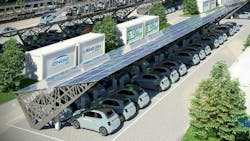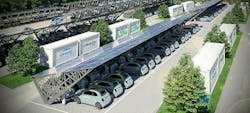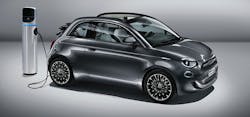Work has begun at the Fiat Chrysler Automobiles (FCA) plant in Mirafiori, Turin on the first phase of a vehicle-to-grid (V2G) pilot project. The initiative is aimed at two-way interaction between FCA’s full electric vehicles (EVs) and the power grid. In addition to recharging cars, the project will use their batteries to provide grid-stabilization services.
By way of review, when an EV is charged, ac from the grid is converted to dc so that it can be used by a car. This conversion is carried out by either the car’s own ac-dc converter or a converter located in the charger. With traditional one-way EV chargers, electricity flows from the electric grid into the electric vehicle. With two-way (bidirectional) EV chargers, electricity can flow both ways.
To send the energy stored in the EV’s battery to the grid, it must be converted back to ac. Thus, a bidirectional EV charger has to contain an internal converter. V2G describes a system in which plug-in electric vehicles, such as battery electric vehicles (BEVs), plug-in hybrids (PHEVs) or hydrogen fuel-cell electric vehicles (FCEVs) communicate with the power grid and return electricity to the grid. Hydrogen fuel-cell vehicles with tanks containing up to 5.6 kg of hydrogen can deliver more than 90 kWh of electricity.
A V2G application can be used to help balance local, regional, or national energy needs. It allows EVs to charge during off-peak hours and send energy back to the grid during peak hours, when there’s extra energy demand. On average, cars remain unused for 80% to 90% of the day. If connected to the network, via V2G technology, customers could receive payment or energy in exchange for the grid balance offered—all without compromising their mobility needs.
Similarly, solar panels clearly capture the most energy during the day, and wind turbines when it’s windy. With bidirectional charging, the full potential of EV battery storage can be realized to benefit the entire energy system. Estimates are that by 2025, the total storage capacity of electric vehicles in Europe will be over 300 GWh. That would represent the largest distributed resource available to the European energy system.
Project Preparation
The site at FCA’s Drosso logistics center, within the Mirafiori complex, covers an area of approximately 3,000 m2. It’s being prepared to host over 10 km of cables required to interconnect the electricity grid with 64 two-way fast-charging points, with an output of up to 50 kW. The infrastructure and control system was designed by Italy’s ENGIE Eps, the energy storage and microgrid division of French utility giant Engie.
Phase 1 of the project, which will see the installation of 32 V2G columns with 64 bidirectional fast-charging points, is scheduled for completion in July. By the end of 2021, the infrastructure will be extended to interconnect up to 700 electric vehicles, capable of providing fast grid services to the transmission network operator, as well as recharging the vehicles themselves. And when complete, the project will be able to provide up to 25 MW of regulatory capacity, making it the largest V2G infrastructure in the world (Fig. 1).
In addition, by aggregating with other FCA “assets” at Mirafiori—including 5 MW of solar-panel capacity—this V2G infrastructure will become a true virtual power plant. It will have the capability to provide power to the equivalent of 8,500 homes and a wide range of services to the network operator.
Fiat 500 and the Panda
The electric Fiat 500, which reportedly will soon roll off FCA’s production line in Turin, is to be used for the start of the project (Fig. 2). In the Fiat 500 EV, a 42-kWh lithium-ion battery sits in the floor and provides about 199 miles of range based on the WLTP cycle used outside the U.S. An EPA-rated figure will likely come in closer to 150 miles. The battery can accept up to 85 kW, which could top up the battery to 80% in about 35 minutes, according to Fiat.
Following the 500 will be the new Fiat Panda EV. To keep the entry price low, Fiat intends to rely on a modular battery concept where owners may extend the basic capacity (100-km-range) with add-on modules as desired. The business model may also include battery rental and leasing, an approach also taken by Renault.
When a bidirectional EV charger is used to supply power from an EV car’s battery to a house or, possibly, another kind of building, the arrangement is known as V2H, or vehicle-to-house. V2H requires charging up an EV at night when there’s less electrical demand, and then using that electricity to power your home during the daytime. In this way, consumption is reduced during peak periods when there’s more electrical demand and more pressure on the grid.
V2H also can help ensure homes have enough power when they most need it, notably during power outages. A typical EV could be used for emergency power for several days (for example, powering lighting, home appliances, etc.). As such they may be seen as a complementary technology for intermittent, renewable power resources such as wind or solar electric.
Other Bidirectional Implementations
Elsewhere, Taiwan’s Delta Electronics developed a bidirectional charging system to convert energy between an EV battery and the ac supply, as well as offer power backup and energy-management features. It can be coupled with an existing photovoltaic (PV) system via ac-link or dc-link architecture for different user scenarios.
Delta’s EV Charging and Discharging System is being employed by Japan’s Kansai Electric Power Co., Ltd. (KEPCO) for KEPCO’s experimental control and grid resource management program as transient loads change. It can successfully charge and discharge within seconds in response to the control system’s instructions.
In Amsterdam, at the Johan Cruyff ArenA, home to the Ajax soccer team, charging and V2G technologies supplement the stadium’s solar and battery storage system. During non-event days, the system transitions into revenue-generating ancillary services. However, during events such as soccer matches and concerts, bidirectional EVs and stationary storage stand ready to shave expensive load peaks and provide backup power if necessary.
In the future, visitors who park in one of the stadium’s 2,400 parking spots will be able to provide energy to the ArenA with their EVs in exchange for monetary rewards or premium parking. Smart stadiums and similar use cases that require large electrical demand for short periods of time can use V2G to capture untapped monetary value.


